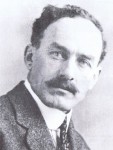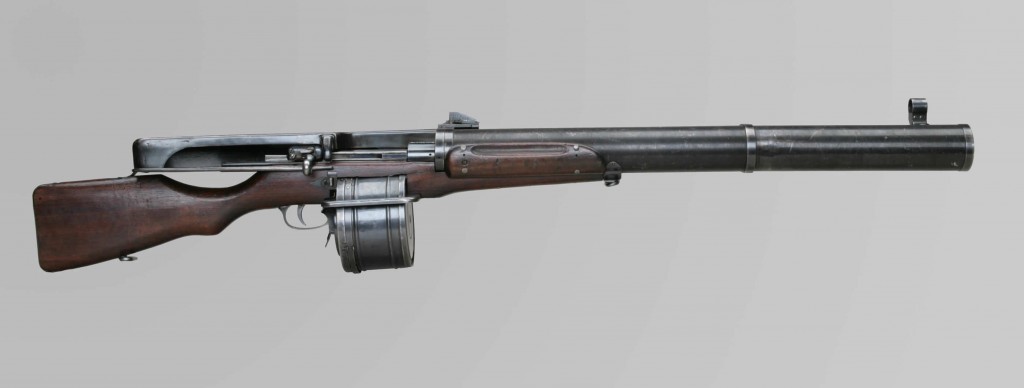The first serious automatic weapon considered for military service in Canada was the brainchild of Joseph Alphonse Huot, a machinist and blacksmith from Quebec. Born in 1878, Huot was a large and strong man (not surprising for a blacksmith), standing 6’1″ tall and weighing in at a muscular 210 pounds. His personality included a great patience and ability to focus and work day and night – but also unfortunately a great deal of trust in other people, which would not benefit his business career.

Huot began his work by experimenting with a small .32 caliber semiautomatic rifle (we don’t know any other details about it) as a hobby project, but when World War I broke out his interest in the gun became more serious. He applied his ideas to a Ross straight-pull rifle (at the time the standard issue arm of the Canadian infantry), and worked with a single assistant from mid-1914 until the end of 1916 perfecting his design. His work resulted in a pair of Canadian patents, numbers 193,724 and 193,725 (unfortunately, neither text nor images from either of these are available through Canada’s online patent archive).

The idea, in broad strokes, was to mount a gas piston off the left side of the barrel. This would tap gas from the barrel near the muzzle and use it to drive a rod which was connected to the bolt of a Ross rifle. Since the Ross was a straight-pull design to begin with, this sort of conversion was mechanically fairly straightforward (although the devil is always in the details of getting it to run smoothly and reliably). In addition to the basic operating piston, Huot designed a ratchet and linkage that would positively index the next round in the drum magazine each time the weapon was fired, thus eliminating the need to rely on a tensioned spring to feed ammunition. He also effected a copy of the the Lewis gun’s cooling mechanism, using the muzzle blast to pull cool air through the large barrel shroud and over a radiator assembly built around the barrel.
Up to September 1916, Huot had been working in a friend’s shop perfecting his design, and on September 8th 1916 he met with a Colonel Matyche in Ottawa. He was hired on the spot as a civilian mechanic for the Small Arms Experimental Department, and while this would ensure continued work on his gun it also spelled disaster for any hopes of financial benefit from his work.

Huot’s private work developing the gun had been quite good, and his original model was demonstrated to military officials in December 1916. An improved version was demonstrated again on February 15, 1917, firing 650 rounds. This demonstration was good enough for the Master-General of Ordnance to request an extended trial, which took place on March 5th and 6th (just two weeks later). This test went through no fewer than 11,000 rounds of ammunition – not a trivial test by any means. At this point, it seems that bureaucracy took over, and the next development in the gun’s story would not come until the Standing Small Arms Committee saw the gun tested again in October 1917. That test led them to send Huot and Major Robert Blair (Assistant Inspector of Small Arms in Quebec) to England for trials there to have the weapon approved by the British military.
They left in late November, arriving in England in early December 1917, and the first tests at Hythe were undertaken on January 10th 1918, with a second round in March. These tests pitted the Huot against the other machine rifles available at the time; the Lewis, Farquhar-Hill, and Hotchkiss. The tests and demonstrations continued until early August 1918, although the Huot was formally rejected by the British military on April 11, 1918.

When compared to the Lewis, the Huot was found to be very competitive. It was better at snap-shooting from a trench, and faster to bring into action. Except for overly-thick cartridge rims, the Huot was faster to clear all types of malfunction than the Lewis, and it was simpler to disassemble. Testing at Enfield in April and May went for 10,000 rounds (which thoroughly trashed the Huot’s barrel; it was found to be keyholing after 6,000 rounds). The Huot was found to be less accurate than the Lewis, although this is probably at least partly due to the sights being attached to the barrel shroud, which was found to have rattled its rivets loose over the course of testing. Lastly, the testers at Enfield complained about the shape of the butt making it difficult to get a good grip on the weapon (not surprising, given the bulk and location of the action cover).
Overall, the Huot had 33 parts directly interchangeable with the Ross M1910 rifle, plus 11 parts that had to be modified from the rifle and an additional 56 parts that had to be made from scratch.
So why was the weapon rejected despite such promising test results? Simple – it wasn’t sufficiently better than the Lewis to justify the expense of retooling production and retraining soldiers. And, of course, once the war ended the existing supply of Lewis guns was suddenly far more than would be needed by a peacetime Army, and there was no need to look for additional such arms.

Sadly, Huot’s personal fortune suffered pretty dismally form the endeavor as well. Any agreement for royalty payments from Canada was contingent upon the gun’s formal acceptance, so when it was rejected he was left with just the salary he had been paid as an employee. The roughly $35,000 investment he had made in the project was left to him to repay (although Huot fought this, and eventually did receive payment of $25,000 in recompense – but only in 1936). His first wife had died days after childbirth in 1915, and he remarried after the war, fathering 5 children with his wife Marie and working as a laborer and eventually city works foreman in Ottawa. He lived until June 1947, continuing to tinker and invent, but never again reaching as close to success as he came with the Huot Automatic Rifle.
Technical Specs
Caliber: .303 British
Magazine capacity: 25 rounds (could be altered for belt feed)
Weight (loaded): 33.25 pounds (15.1kg)
Rate of fire: 470 rounds/minute
Bibliography
Dupuis, Frank J. “The Huot Automatic Rifle” Published in The Canadian Journal: Arms Collecting, 1973.

Note this gun is cheaper than the thompson, why no one knows this beauty?
We at the Seaforth Museum still have the Huot-Ross (serial No. 2), which is pictured here being held by Col. Blair, in our collection. We also have the trials documents which include comments on function, torture testing (over 30K rounds), and a brief field display in France. It performed better than the contemporary Lewis Gun in almost all respects.
Thanks for infos ! It sure is a unique piece of history.
The weapon-powered magazine is a nice feature. How was it reloaded? Was it meant to be changed out when empty, or reloaded (w/ strippers or loose rds) in place?
Changed out. The empty mags were filled with 25 round stripper clips.
Was Major Robert Blair African American? I have a picture of a Robert Blair that says he was the inventer of the anti-aircraft gun.
This is a different Blair: https://www.forgottenweapons.com/wp-content/uploads/2013/07/blair.jpg